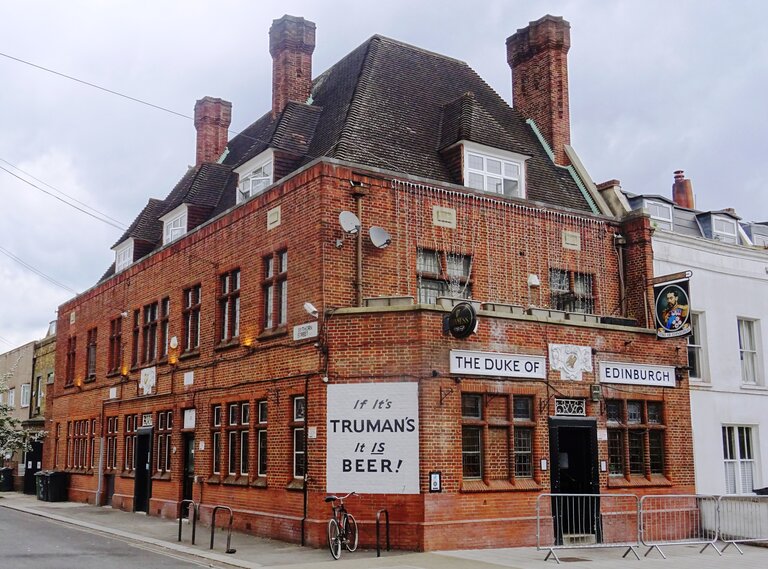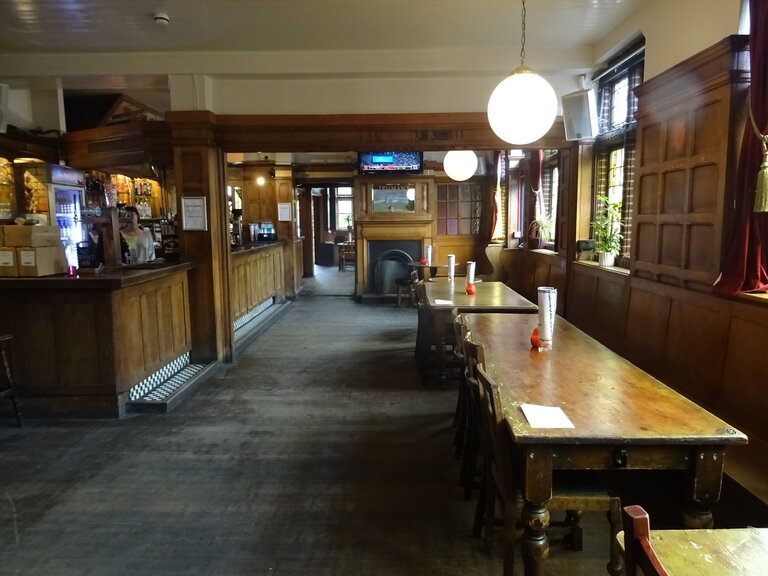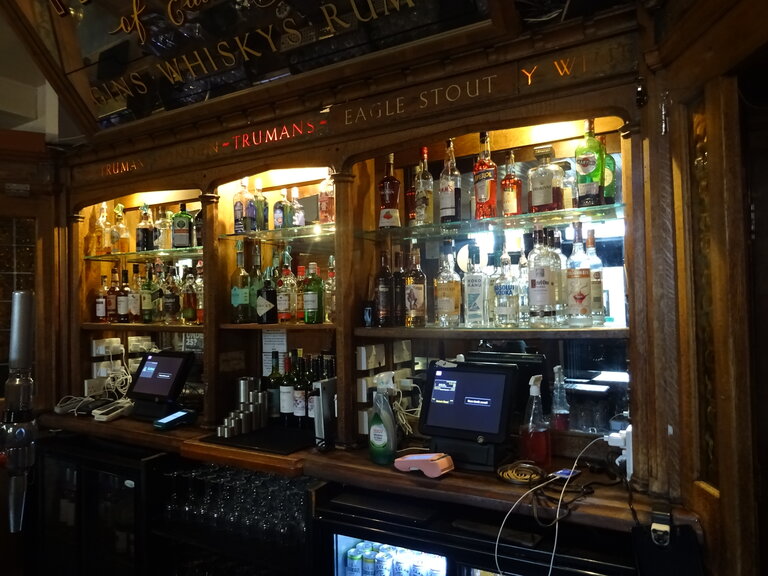Duke of Edinburgh
204 Ferndale Rd,Brixton,
SW9 8AG
This pub is not only a grade II listed building, it is also a Two Star pub on the Campaign for Real Ale’s (CAMRA) National Inventory with an interior of very special national historic interest, and the description is as follows: “A beautifully crafted piece of 1930s suburban pub architecture by Truman’s, it has three storeys and is faced with attractive thin red bricks which have also been used for the window linings and mullions. Inside you can now perambulate through the whole pub but can still get a good sense of the way it was originally arranged. The public bar was at the front and more simply appointed than the more upmarket rear areas, e.g. a match-board counter in contrast to the panelled ones behind – note all the counters have doors for servicing the original beer engines as was usual in Truman’s 1930s pubs. The light-coloured oak woodwork is typical of the colouration and quality of what they put into their pubs, as is the distinctive advertising lettering in the bar-backs, the chequerwork spittoon trough in the rear area, the use of mirrors over the fireplaces and the (now disappeared) sliding screen that would have split the rear parts. The inglenook with Tudor-arched fireplace and adjacent seating is particularly attractive. Unusually cellar access for deliveries is inside the pub with access via two wooden doors underneath one of the mullioned windows. A notable feature is the extensive rear garden approached down a passage at the rear and which shows how inter-war pub builders had in mind the need to encourage not just hardened drinkers but couples and families who might enjoy sitting out in good weather.”
The listing description is as follows: “Summary 'Improved' public house, 1936-7, by A E Sewell, for the brewery Truman, Hanbury, Buxton & Co. Ltd.
Reasons for Designation The Duke of Edinburgh public house, Ferndale Road, Brixton, built 1936-7, to the designs of A E Sewell as an ‘improved’ public house for the brewery Truman, Hanbury, Buxton & Co. Ltd, is listed at Grade II for the following principal reasons:
Architectural interest handsome and stylistically restrained, with extensive use of good-quality materials and careful, understated detailing, the building exemplifies the character of the inter-war ‘improved’ public house; * Planning interest: the building’s layout of public rooms of varying function and status, arranged around a continuous bar, remains readily legible and illustrates a key tenet of the ‘improved’ typology; * Level of survival: the building survives very little-altered internally and externally, its light oak joinery and coloured leaded-light windows reflecting elements of the Truman’s ‘house style’; * Architect and client: the building was designed for Truman’s, one of the breweries most prolific in their inter-war pub building, by their in-house architect A E Sewell, a pub designer of considerable note.
History Inter-war ‘improved’ or ‘reformed’ pubs stemmed from a desire to cut back on the amount of drunkenness associated with conventional Victorian and Edwardian public houses. Licensing magistrates and breweries combined to improve the facilities and reputation of the building type. Improved pubs were generally more spacious than their predecessors, often with restaurant facilities, function rooms and gardens, and consciously appealed to families and to a mix of incomes and classes. Central, island serveries with counters opening onto several bar areas allowed the monitoring of customers and also the efficient distribution of staff to whichever area needed service. Many, although not all, of the new pubs were built as an accompaniment to new suburban development around cities, and a policy of ‘fewer and better’ was followed by magistrates both in town and on the outskirts. A licence might be granted for a new establishment on surrender of one or more licences for smaller urban premises. Approximately 1,000 new pubs were built in the 1920s – the vast majority of them on ‘improved’ lines - and almost 2,000 in the period 1935-39. Neo-Tudor and Neo-Georgian were the favoured styles, although others began to appear at the end of the period. Brixton emerged as a suburban centre in the middle of the C19, and by the 1880s Brixton Road had become an important commercial area in suburban South London, with Electric Avenue (built 1888) becoming the first electrically-lit street in London. The Duke of Edinburgh is situated on Ferndale Road (formerly Shepherd’s Lane), a residential street off Brixton Road to the west of Brixton Market and the railway station. The original Duke of Edinburgh pub – on the same site as the current pub - is thought to have dated from c1860. Across the road, Ferndale Court (now the Edmundsbury Court Estate) was built in 1927-29 as flats for members of the City of London police force; its construction probably provided the stimulus for the rebuilding of the pub shortly after. The new Duke of Edinburgh was completed in 1937, to the designs of A E Sewell (1872-1946), principal architect for the East London-based brewers Truman, Hanbury, Buxton & Co, founded in c1666. Plans, sections and elevations of the pub – signed by Sewell and dated March 1936 – survive in Lambeth Archives. As designed, the pub had a public bar and interconnecting games room to the south end, entered via Ferndale Road; and a saloon bar and lounge and billiard room, entered from the west, via Bythorn Street. In between the two set of rooms was a small self-contained outdoor department (or off licence), also entered via Bythorn Street. At some point the ground floor rooms of the building were opened up, with the glazed screens (and in one case a short piece of wall) which separated the spaces, removed; otherwise the pub is largely unaltered. To the rear The Duke of Edinburgh has an extensive garden, accessed via the passage at the north of the building, opening off Bythorn Street. It retains crazy paving and low stone retaining walls, which may be original to the 1930s garden scheme.
Details The Duke of Edinburgh, 1936-7, by A E Sewell, built as an ‘improved’ public house for the brewery Truman, Hanbury, Buxton & Co. Ltd.
MATERIALS: the building is faced in thin red bricks laid in English bond, with sparing use of stone dressings. The windows are metal casements with square leaded lights, set within moulded brick mullioned and transomed surrounds. The roof is covered in clay tiles.
PLAN: the building occupies a narrow rectangular plot on the corner of Ferndale Road and Bythorn Street, with the main elevation facing southwards onto the former. On the Ferndale Road frontage the pub joins the two-storey terraced housing of c1860 and on the Bythorn Street elevation it is separated from further terraced housing by a passage accessing the pub’s private entrance and the rear garden. The pub consists of two main storeys, in addition to a cellar, and an attic in the steeply pitched hipped roof. The ground floor of the Ferndale Road façade projects forward and has a distinctive splayed corner, common in Truman’s pubs built on corner plots between the wars. Internally the original pub rooms have been opened up to one another and wrap around a long L-shaped bar.
EXTERIOR: both the south and west frontages are characterised by flat brick elevations with symmetrically ordered chamfered brick mullion and transom windows, the roof being punctuated by dormer windows along with three substantial brick chimneystacks. The survival of Sewell’s original elevation drawings, along with an early photograph, shows that the exterior of the Duke of Edinburgh survives as built. The central doorway on the Ferndale Road front (originally serving the public bar), and that at the centre of the Bythorn Street elevation (serving the saloon bar), are both topped by wrought iron screened fanlights, and above these are decorative sculpted stone relief panels, with Baroque style roundels inset with the Truman’s eagle emblem. To the north side of the Bythorn Street frontage is a set of rolling-in doors, beneath a window, which are paired with a set of internal cellar flaps, which would have allowed brewery draymen to deliver barrels of beer directly from the street. Throughout, the windows are original – retaining their decorative leaded and stained glazing – and all of the pub’s doors remain, though that which originally led into the saloon bar is no longer in use.
INTERIOR: as with the exterior of the Duke of Edinburgh, the pub’s interior survives very little altered and is a typical example of Truman’s inter-war ‘house style’, with features such as embossed branded mirrors, light-coloured oak panelling, and brick and moulded timber fireplaces. Although most of the internal divisions between the rooms have been lost, the 1937 plan form remains apparent in the retention of original doors to the formerly separate bars, remnants of the dividing screens, and the varied treatment of the rooms.
The public bar and games room on the south are the most rudimentary of the pub’s rooms, with simple Truman’s matchboard panelling to dado level, the bar counter being panelled in the same fashion. A shallow arched brick fireplace is retained in the public bar along with all of the original fixed benching. Behind the counter is the original tripartite oak bar back, with a set of three recessed mirrored panels serving as back boards. The bar back has thin octagonal-faced columns set beneath a trio of shallow four-centred arches. The bar back in this section serves to screen off a private office which is accessed through a door on the west side of the servery. The office arrangement remains as built. The public bar and games room were served by lavatories for men and women, placed at the pub’s south-west corner. The toilets survive in this location today, though for women only, and with modern fittings.
The former division between the public bar and the games room is clear from the remaining upper glazed portion of a screen, which runs perpendicular to the counter across the room, and from the supporting piers. The bar counter continues (forming the return of that serving the public bar). The room also has original matchboard panelling and there is a short stretch of original fixed oak benching. From this room there is now access through the former off sales department to the saloon bar. The space which was formerly used as the off sales department is retained, and the original doorway remains in use as the main route of access to the west side of the pub. The counter which served this area, along with two of the screens which sectioned it off from the saloon bar and games room, have been removed. However, the stretch of bar counter which now serves this space matches that in the games room and public bar, suggesting the off sales counter may simply have been moved back in line with the rest of the bar. The fittings and fixtures in the saloon bar identify it as of a higher status than the public bar and games room. This area is fitted with picture-rail height fielded panelling throughout and has its original bar counter, also featuring fielded oak panelling, as well as counter doors and a chequer-pattern tiled border. Behind the counter, the three-part bar back matches that in the public bar. To either side of the bar back a leaded glazed screen projects diagonally across the space behind the counter (though allowing a through-way for staff), marking the bar counter divide between the saloon bar and the lounge and billiard room on one side, and what was the off sales department to the other. The saloon retains a fireplace with a moulded oak surround and overmantel and an inset Truman’s embossed mirror. This fireplace adjoins an L-shaped section of fixed settle-type benching beneath a leaded window through to what was the adjoining off sales department. The north end of the building is occupied by what was formerly the large lounge and billiard room. This was accessed via the saloon bar through a door in a glazed screen, now largely lost, though remnants of the side and upper potions survive. As a class of room, lounge bars were a new development of inter-war pubs, constituting the most socially elite portion of the building. The lounge and billiard room was served by a short counter, formed of the return of the long saloon bar counter (separated by the diagonal screen mentioned above). The room features picture-rail height panelling throughout and has an inglenook fireplace on the east wall. This contains a broad central stone fireplace, the fielded panelling above being inset with an embossed Truman’s mirror, flanked by leaded stained-glass windows on either side, with fixed settle-type benching set into the splayed, oak panelled, returning walls. The room was served by male and female toilets, both of these surviving (although now solely for men’s use), flanking the inglenook. The far end are double doors leading out to the passage and garden. The current doors are modern replacements, but they retain their original fanlights, with leaded and stained glazing. The upper floors of the pub were not inspected but house a kitchen and staff accommodation.
Sources Books and journals Cole, Emily, The Urban and Suburban Public House in Inter-War England, 1918-1939’, Historic England Research Report Series, no. 4/2015, (2015), section 12.16”
TheWhatpub link is here: WhatPub/Duke of Edinburgh
The Pub Heritage Group link is here: PHG/Duke of Edinburgh
The Duke of Edinburgh featured on the Evening Crawl of Brixton, Herne Hill and Camberwell on 14 April 2009, the From Trumans to Trinity: Evening Crawl of Stockwell and Brixton on 20 August 2014, and the A River Runs Through It: The Brixton Six: Evening Crawl of Brixton on 24 April 2019
 Exterior
Exterior
 Inglenook Fireplace
Inglenook Fireplace
 Interior
Interior
 Servery with Truman's Signage
Servery with Truman's Signage
 Servery with Truman's Signage
Servery with Truman's Signage
